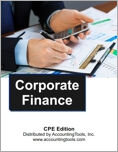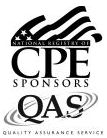Corporate Finance (CPE Course)
CPE Credit: 15 hours
Course Type: Downloaded PDF materials with online test
Price (with PDF Textbook): $100

Course Description
A thorough knowledge of finance is needed in order to successfully operate a business of any size. Corporate Finance
concentrates on the finance essentials needed to run a business, including fund raising, internal cash management, and the deployment of funds to dividends, capital expenditures, investments, and acquisitions. It also addresses such core issues as how to develop an appropriate capital structure and determine the best types of available funding. Another key element of corporate finance is risk management, which the course covers by discussing risk management for foreign exchange and interest rates. In short, Corporate Finance
provides the finance professional with a complete toolkit of solutions.
Author: Steven Bragg
Course Number: FN1017
Table of Contents
Chapter 1. Overview of Corporate Finance
Chapter 2. Capital Structure
Chapter 3. Financial Planning
Chapter 4. Early-Stage Financing
Chapter 5. The Initial Public Offering
Chapter 6. Other Capital Raising Alternatives
Chapter 7. Debt Financing
Chapter 8. Leasing
Chapter 9. The Cost of Capital
Chapter 10. Discounted Cash Flows
Chapter 11. Working Capital Management
Chapter 12. Capital Expenditures
Chapter 13. Investment Alternatives
Chapter 14. Dividends and Other Payouts
Chapter 15. Mergers and Acquisitions
Chapter 16. Foreign Exchange Risk Management
Chapter 17. Interest Rate Risk Management
Chapter 18. Supply Chain Financing
Chapter 19. Corporate Finance Measurements
Learning Objectives
-
Recognize the players involved in the practice of corporate finance.
-
Specify the components of capital structure, and the situations that may call for its revision.
-
Identify the methods used to construct financial plans, and the reliability of the component information.
-
Specify the negative aspects associated with the use of certain types of early-stage financing.
-
Recognize the steps involved in the initial public offering, and the restrictions placed on a business during that time.
-
Identify the different techniques available for selling shares outside of an initial public offering, and the restrictions associated with their use.
-
Identify the elements of a lease versus buy analysis.
-
Specify the characteristics of the different types of leases.
-
Identify the formula components for the cost of capital, and the costs associated with each one.
-
Recognize the different discounted cash flow concepts, and how they are used.
-
Identify the techniques used to control the amount of funds invested in working capital.
-
Cite the alternatives available for determining the worthiness of proposed capital expenditures.
-
Identify the different investment strategies, and the characteristics of the more common financial instruments.
-
Identify the dividend payout formula, the implications of a high ratio, and the impact on investors when dividends are first issued.
-
Recognize the different types of acquisition strategies and valuation methods, as well as the implications of making different types of payment offers to the owners of an acquisition target.
-
Specify the hedging techniques used to mitigate foreign exchange risk.
-
Cite the hedging techniques used to mitigate interest rate risk.
-
Identify the conditions under which supply chain financing is most likely to be accepted by suppliers.
-
Recognize the ratios used to measure the ability to pay, and the contents of the ratio formulas.
-
Specify the instances in which ratios can give misleading results.
Level: Overview
Instructional Method: QAS Self-Study
NASBA Category: Finance
Prerequisites: None
Advance Preparation: None
Latest Review Date:November 2023
Program Registration Requirements: Click on "Purchase Course" near the top of this page to pay for and access the course. You will then be able to download the course as a PDF file, then take an on-line examination, and then download a certificate of completion if you pass the examination.
Program Refund Policy: For more information regarding administrative policies concerning complaints, refunds, and other matters, see our policies page.

AccountingTools, Inc. is registered with the National Association of State Boards of Accountancy (NASBA) as a sponsor of continuing professional education on the National Registry of CPE Sponsors. State boards of accountancy have the final authority on the acceptance of individual courses for CPE credit. Complaints regarding registered sponsors may be submitted to the National Registry of CPE Sponsors through its website: www.nasbaregistry.org .
The NASBA sponsor identification number for Accountingtools, Inc. is 115881.

AccountingTools is an IRS Approved Continuing Education Provider. We are compliant with the requirements for continuing education providers (as described in sections 10.6 and 10.9 of the Department of Treasury’s Circular No. 230 and in other IRS guidance, forms, and instructions). Our IRS Approved Continuing Education Provider number is 72821.

